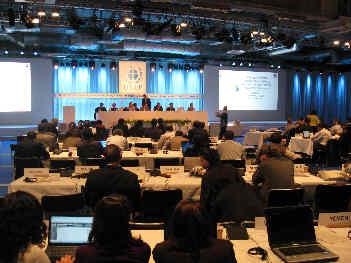Minamata Convention on Mercury
On November 6, 2013 the United States signed the Minamata Convention on Mercury, Exit a new multilateral environmental agreement that addresses specific human activities which are contributing to widespread mercury pollution. Implementation of this agreement will help reduce global mercury pollution over the coming decades. In addition to signing, the United States deposited its Instrument of Acceptance to become a party to the Convention. EPA worked closely with the State Department and other federal agencies in the negotiation of this agreement.
The text of the Minamata Convention (PDF) Exit was adopted by delegates from over 140 countries on January 19, 2013, after three years of negotiation. The Convention opened for signature at the Diplomatic Conference in Kumamoto, Japan, on October 10, 2013. The Convention will enter into force after 50 countries have joined.
The Convention is named after the Japanese city of Minamata, which experienced a severe, decades-long incidence of mercury poisoning after industrial wastewater from a chemical factory was discharged into Minamata Bay. The wastewater contained methylmercury, which bioaccumulated in fish and shellfish in the bay. Local people who consumed seafood from Minamata Bay became very sick, and many died or were left severely disabled.
Learn more:
- How does mercury threaten our health?
- Why is a global response needed?
- What will the Minamata Covention require?
- A Global Opportunity
- Additional Resources
How does mercury threaten our health?
Exposure to mercury threatens our health, with many often irreversible toxic effects. Developing fetuses and young children are most at risk. Mercury pollution also harms wildlife and ecosystems.
Mercury occurs naturally in the earth’s crust, but human activities, such as mining and fossil fuel combustion, have led to widespread global mercury pollution. Mercury emitted into the air eventually settles into water or onto land where it can be washed into water. Once deposited, certain microorganisms can change it into methylmercury, a highly toxic form that builds up in fish, shellfish and animals that eat fish. Most human exposure to mercury is from eating fish and shellfish contaminated with methylmercury, both in the United States and worldwide.
Almost all people in the world have at least trace amounts of methylmercury in their tissues, reflecting its pervasive presence in the environment. Some communities eat significantly more quantities of fish than the general population, and thus may be exposed to much greater mercury contamination than the general population. It is estimated that more than 75,000 newborns in the United States each year may have increased risk of learning disabilities associated with in-utero exposure to methylmercury.
- Learn more about the toxic effects of mercury.
- Learn more about mercury exposure in the United States.
- Press release: FDA and EPA issue updated draft advice for fish consumption
Why is a global response needed?
Mercury pollution is a global problem that requires global action because it moves with air and water, transcends political borders, and can be transported thousands of miles in the atmosphere.
In the United States, we are significantly reducing our use and emissions of mercury, but domestic efforts alone are not sufficient to address the effects of mercury pollution. According to some estimates, global sources contribute about 70 percent of mercury deposited in the contiguous United States, although the percentage varies geographically. These global sources include natural sources, re-emitted mercury, and man-made emissions from other countries.
- Learn more about the global context for mercury emissions.
- Learn more about how the United States is reducing our use and emissions of mercury.
What will the Minamata Covention require?
The Minamata Convention, once in force, will require party nations to:

Delegates assemble at plenary session of first intergovernmental negotiating committee meeting in Stockholm, Sweden in June 2010. Photo Credit: Carl Mazza.
- Reduce and where feasible eliminate the use and release of mercury from artisanal and small-scale gold mining.
- Control mercury air emissions from coal-fired power plants, coal-fired industrial boilers, certain non-ferrous metals production operations, waste incineration and cement production.
- Phase-out or take measures to reduce mercury use in certain products such as batteries, switches, lights, cosmetics, pesticides and measuring devices, and create initiatives to reduce the use of mercury in dental amalgam.
- Phase out or reduce the use of mercury in manufacturing processes such as chlor-alkali production, vinyl chloride monomer production, and acetaldehyde production.
- In addition, the Convention addresses the supply and trade of mercury; safer storage and disposal, and strategies to address contaminated sites.
- The Convention includes provisions for technical assistance, information exchange, public awareness, and research and monitoring. It also requires Parties to report on measures taken to implement certain provisions. The Convention will be periodically evaluated to assess its effectiveness at meeting its objective of protecting human health and the environment from mercury pollution.
A Global Opportunity
The new Minamata Convention on Mercury is an opportunity for the global community to address this mounting problem before it gets worse. Over the next decades, implementation of this international agreement will help reduce mercury pollution from the specific human activities responsible for the most significant mercury releases to the environment.
Additional Resources
- Read the text of the Minamata Convention Exit
- Explore EPA's leadership and specific activities in the Global Mercury Partnership.
- Learn more about the UNEP Global Mercury Partnership,Exit including information on becoming a partner.
- Our work on the international stage to control mercury use and emissions is an important complement to our strong domestic actions on mercury.
- United States Department of State: Minamata Convention
- UNEP Global Mercury Assessment 2013: Sources, emissions, releases, and environmental transport Exit
- Decisions adopted (PDF) Exit at the 25th Session of the UNEP Governing Council (see Decision 25/5, Chemicals including Mercury)
Contacts
For additional information on EPA's work with mercury, contact:
Rodges Ankrah
U.S. Environmental Protection Agency
Office of International and Tribal Affairs (2670R)
1200 Pennsylvania Ave., NW
Washington, DC 20460
E-mail: ankrah.rodges@epa.gov
(202) 564-0280
